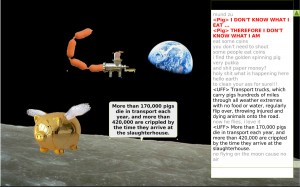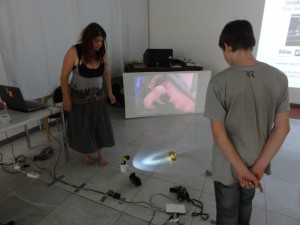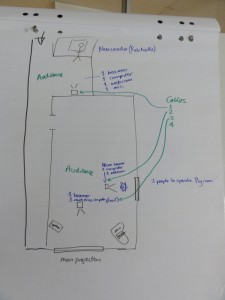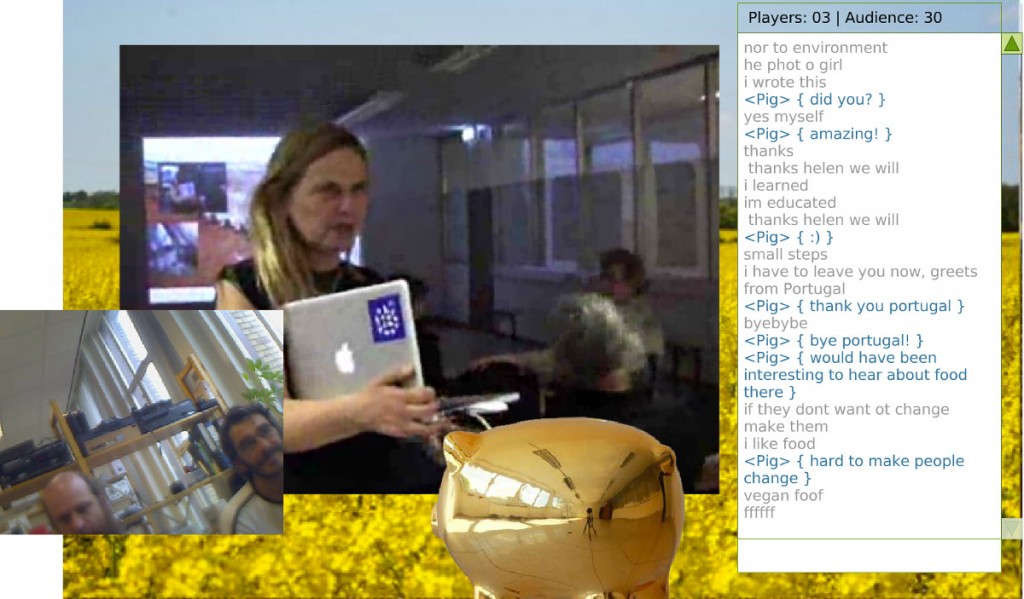 From the politics of local food production to genetic modification to the impact of the world-wide decline of bees on food production, we once again had a wide-ranging situation and a plethora of research material to draw on for the Graz situation, titled “Unidentified Flying Food”. Industrial pig farming was quickly identified as not only a controversial local issue but a good connector with the previous situation in Eindhoven, where our research also uncovered unethical treatment of pigs. Thus our protagonist became Pig, a shiny gold piggybank who embodied capitalist food production values.
From the politics of local food production to genetic modification to the impact of the world-wide decline of bees on food production, we once again had a wide-ranging situation and a plethora of research material to draw on for the Graz situation, titled “Unidentified Flying Food”. Industrial pig farming was quickly identified as not only a controversial local issue but a good connector with the previous situation in Eindhoven, where our research also uncovered unethical treatment of pigs. Thus our protagonist became Pig, a shiny gold piggybank who embodied capitalist food production values.
Happily, the performance began with Pig breaking out from her tiny prison (she was a she because male piglets are routinely slaughtered at birth because, like male chicks, they have less value and potentially cause trouble in the pens) and embarking on a journey through the tourist version of the Styrian region of Austria. Along the way she began to encounter the problems – loss of bee population, loss of biodiversity due to corporate farming practices, brutal animal transportation, and our general lack of knowledge about what we are actually eating. Pig’s journey was punctuated by news flashes from an intrepid reporter investigating reports of UFFs (Unidentified Flying Food) over Austria, including interviewing audience members, until finally Pig herself was interviewed and she plunged into an existential crisis, asking the audience whether she should return to the relative comfort and security of the cage or stay out in the confusing, poisonous world.
 One of the things we experimented with was using a video as a backdrop within a stream. At left, Alex and Ricardo have set up a small video projection and are working out the camera angle and lighting to position Pig within the video and then stream the whole composition. Pig’s cage was a graphic of bars layered over the stream, which was animated to break open when hands (Maja and Sanja’s) reached in from either side of the frame. The timing of this was difficult to coordinate, and probably did not work for everyone as online audience may have recieved the stream with slightly different degrees of delay – but when it worked it was very effective. The “real” pig then journeyed across the video several times before turning into a pig avatar with the full screen to move in.
One of the things we experimented with was using a video as a backdrop within a stream. At left, Alex and Ricardo have set up a small video projection and are working out the camera angle and lighting to position Pig within the video and then stream the whole composition. Pig’s cage was a graphic of bars layered over the stream, which was animated to break open when hands (Maja and Sanja’s) reached in from either side of the frame. The timing of this was difficult to coordinate, and probably did not work for everyone as online audience may have recieved the stream with slightly different degrees of delay – but when it worked it was very effective. The “real” pig then journeyed across the video several times before turning into a pig avatar with the full screen to move in.
 A particular situation that we had to deal with in Graz was that the network at the venue was simply not fast enough for us to do everything we needed to do. We knew this well before the workshop started, as Eva and Martin conducted speed tests on the network, and Eva spent a lot of time trying to find a solution. In the end it was not possible to increase the speed of the network, so we had to limit the number of computers online during the performance and purchased two mobile internet sticks in order to have the best possible speed for the two streams we wanted to send out. We managed to have all the other computers on ethernet cable, so no-one was dependent on the wi-fi, but it still felt risky using mobile internet for the streams. When the audience arrived we asked them not only to make their phones silent but to switch them completely off, in case one was on the same network as our sticks and happened to recieve data during the show. All of this planning paid off and we did not have any network problems during the event.
A particular situation that we had to deal with in Graz was that the network at the venue was simply not fast enough for us to do everything we needed to do. We knew this well before the workshop started, as Eva and Martin conducted speed tests on the network, and Eva spent a lot of time trying to find a solution. In the end it was not possible to increase the speed of the network, so we had to limit the number of computers online during the performance and purchased two mobile internet sticks in order to have the best possible speed for the two streams we wanted to send out. We managed to have all the other computers on ethernet cable, so no-one was dependent on the wi-fi, but it still felt risky using mobile internet for the streams. When the audience arrived we asked them not only to make their phones silent but to switch them completely off, in case one was on the same network as our sticks and happened to recieve data during the show. All of this planning paid off and we did not have any network problems during the event.
As this was the fourth situation, the last in this particular project, and we had had a three-week break after the Eindhoven situation, we had been able to reflect on the previous three situations and build on this experience. Addressing network issues as early as possible was one of the lessons, and in Graz this definitely meant we were able to find the best solution without panicking. We made adjustments to the workshop process and ensured that we communicated better with the remote participants in London and Eindhoven, providing an outline after the second day of the workshop and a proper script before the first rehearsal. Yes, that’s right, I said first rehearsal, because this time we managed to have two rehearsals. This was due to having the performance scheduled for the day after the last day of the workshop. In fact, the day of the performance became an extra day of the workshop – or at least a half day, as we started the morning with a very interesting guided tour of Kunsthaus Graz.
We also tried to improve the discussion part of the event; this time, the London participants were very motivated, joining us online during the first introductory meeting, then having a proper stream test including audio testing, and preparing a short response to the performance. This was presented as a segue between the performance and the discussion, and it worked very well. We had maintained daily communication with London via email and sometimes also the stream, keeping them up to date with both the research and the developing performance. The discussion was still focussed on the audience at the venue in Graz, but we wove in online audience comments as much as possible and also had the silent presence of Eindhoven. Facilitating a conversation between a gathered audience and distributed online participants is extremely difficult, but the online audience remained engaged throughout the discussion, commenting freely in the text chat; and after a while some audience members in Graz began to respond in the text chat as well. Below is a screengrab showing Eva facilitating the discussion in Graz, with the golden Pig looking on and the Eindhoven stream in the lower left corner.
